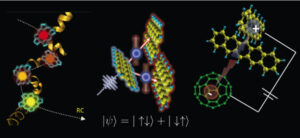Member
Alex Chin
All quantum technology (QT) attempts to exploit the non-classical properties of light and matter to achieve supremacy and potentially exponential efficiencies over classical deterministic approaches in tasks such as computation, communications, sensing, and metrology [1]. However, highly entangled quantum states – and in particular many-body states – are subject to deleterious effects resulting from the pervasive action of uncontrollable interactions between quantum systems and the unobservable and constantly fluctuating degrees of freedom of their environment. This leads to rapid and irreversible processes such as decoherence and thermalization that destroy quantum technological resources, such as multiparty entanglement, and currently limit the development of any evolutionary QT. My work explores the microscopic, real-time, non-equilibrium physics of decoherence and the rich theoretical phenomenology of “open quantum systems”. By modeling, simulating, and analyzing the fundamental interactions of quantum systems with a large number of environmental degrees of freedom, we hope to provide insight into the potential control and suppression of noise and error sources in realistic solid-state platforms for future QTs. In addition, we are also developing powerful theoretical methods to study the dynamics of highly non-perturbative open quantum systems, allowing us to explore the world of biological and organic optoelectronic materials. This work in tensor network dynamics [2] has been a decisive contribution to the fascinating and rapidly growing field of “molecular quantum technologies” where – somewhat surprisingly – an interplay between dissipative and coherent quantum dynamics could be exploited in functional quantum materials specifically designed for a wide range of organic energy harvesting and catalytic applications [3].

Légende: Strongly coupled open quantum systems arise naturally in organic systems, leading to new quantum dynamics with potential advantages for energy applications. (Left) Nanoscale photosynthetic proteins efficiently transport and focus excitons through coherently delocalized states. (Middle) In singular fission, a photoexcitation spontaneously generates a pair of spin-entangled excitons that can distribute quantum resources in the solid state [2]. (Right) Non-Markovian effects and the ultrafast transition from the classical to the quantum state induced by molecular environments may play a key role in the critical charge separation event in organic photovoltaics [3].
Main collaborations and funded projects
- Lovett Group, St Andrews (UK) : “Quantum dynamics and control of bio-inspired nanomachines”. Bi-Lateral funding: The Directorate General of Armaments (DGA) and the Defence Science and Technology Laboratory (DSTL).
- Rao Group, University of Cambridge (UK): Various projects related to the prediction and observation of spatio-temporally resolved open quantum dynamics in organic nanostructures
Publications
[1] Quantum Metrology in Non-Markovian Environments. Alex W. Chin, Susana F. Huelga, and Martin B. Plenio. Quantum Metrology in Non-Markovian Environments.Phys. Rev. Lett. 109, 233601(2012). https://journals.aps.org/prl/references/10.1103/PhysRevLett.109.233601
[2] Florian Schröder, David Turban, Andrew Musser, Nicholas Hine, Alex Chin. Tensor network simulation of multi-environmental open quantum dynamics via machine learning and entanglement renormalisation. Nature Communications, Nature Publishing Group, 2019, 10 (1), ⟨10.1038/s41467-019-09039-7⟩. ⟨hal-02377569⟩
[3] S Gélinas, A Rao, A Kumar, SL Smith, AW Chin. Ultrafast long-range charge separation in organic semiconductor photovoltaic diodes. Science 343 (6170), 512-516 (2014).https://science.sciencemag.org/content/343/6170/512.full

